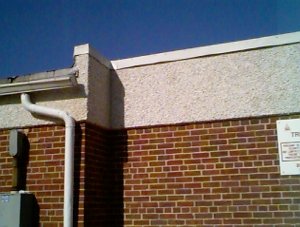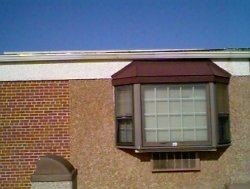Finestone aggregated stucco
"Finestone" was the brand name of an aggregated stucco finish that was popular in the 1950's and 1960's.
The generic name is just aggregated stucco finish, but usually was referred to as Finestone, a system made by Finestone Corporation.
Finestone was an expensive method of stucco, requiring more skill and more materials than more conventional stucco.
Aggregated finishes were far less expensive than exposed aggregate concrete, that finestone was made to duplicate. You can't tell it's stucco unless you get close up.


We did this Finestone in 1992, with finish coat materials from Finestone Corporation. Finestone supplied the cement, the rocks screened to size, the acrylic additive that made this all work, and the clear sealer that protected against stains, and helped hold the rocks in place.
At one time,a contractor needed a franchise to apply Finestone. Included in the franchise was national advertising support, an intense 2 week training class for foremen, and the right to buy Finestone materials.
I had an original Finestone training manual from the 1970's that someone gave me, but unfortunately I lost it away. At least I read most of it.
We also did this color Finestone in 1992. The rocks were checked by Finestone to make sure they didn't contain iron oxide, which could stain the finished wall. Here we used a reddish mortar and a reddish river stone, also made by Finestone.
Sorry for the teeny pictures. These have been on my site since 1999, when page loading time was more critical.
At least you can see that this is a beautiful material, and looks like precast concrete from a distance.
MYSTIC SECRET REVEALED !
The biggest mystic secret of Finestone was to seal the basecoat with acrylic before applying the finish.
This kills the suction of the basecoat. In other words, if you don't do this, the mortar will set up too fast, and the rocks won't stick when you throw them in.
The finish coat has an acrylic admixture mixed in and has an incredibly strong bond. Take this from someone who has patched this before, and had to chip off some of the finish with a chisel.
Here's a view of the finish we are trying to duplicate.
Finestone was an innovator in color stucco finishes, and the use of acrylics in stucco finish.
Not only is Finestone beautiful, but is extremely hard, and well bonded.
Color aggregates such as broken glass and colored rocks can be added fo different decorative effects.
One usually has to look close to tell that this is stucco, and not exposed aggregate concrete..
ANOTHER MYSTIC SECRET !
The brown coat must be dead straight for this to look right. Any hollows, and the rocks will embed too far causing a "bald" appearance.
Likewise, any humps in the wall will prevent the rocks from being embedded deep enough, creating a "hairy" appearance.
These areas are visible from a distance, more so than close up, due to the shadowing of the rocks. We used string lines and plumb bobs years ago when we did this to make sure the wall was straight.
Throwing on the rocks. This is called "seeding". Finestone called this "hand injecting". There are also guns made for this than are used with an air compressor.
Plenty of acrylic is used in the mortar. We used Flex-con half and half with water, like we usually use in our finish coat anyway.
Sadly, I don't think Finestone corporation still makes their aggregated stucco finish. I think all they do now is make synthetic garbage.
Finestone was an innovator in beautiful and durable stucco finishes.